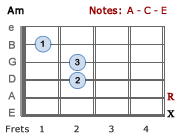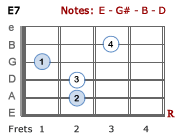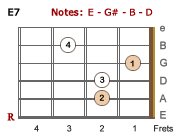Writing Chords
How to read guitar chords in written and tab formWriting chords for guitar is a quick and simple way of displaying a chord without the use of a chord chart. The great advantage of written chords and tabbed chords is that they are the same for right and left-handed guitarists. There are some simple rules to remember, and once you learn them, you will find this form of reading chords very useful.
Reading guitar chords in written form
When writing guitar chords, there are 2 things you need to remember. You will see a series of 6 segments representing guitar strings in the form of numbers and the occasional 'x', e.g., x00232 (D Major).- Each segment represents a guitar string: the first segment represents bottom E, the fattest and lowest sounding string while the last segment represents top E which is the thinnest and highest sounding string. We often write top E using lower-case 'e' to differentiate between the 2 strings. Therefore, all six segments represent each of the six strings EADGBe... always in that order
- The number in each segment represents the fret that is played on that string. '0' means you play the string open, while 'x' means you don't play the string.
Examples of Written Chords
| G7 chord - First Position | Am chord - First Position |
 |
 |
| 320001 | x02210 |
|
|
Although this method of writing chords doesn't show you which fingers to use, you can generally work it out once you know which frets are required. If you play each note with precision and clarity and the chord is comfortable to play, then they are the right finger positions.
Next time you see chords written this way, you will know exactly what to do. The same applies in a situation where some-one other than yourself wants to know how to play a particular chord. You can write it down and explain the 2 points discussed earlier, and there you have it... no charts either.

Written chords beyond the 9th fret
If a written chord is played high up the neck beyond the 9th fret, the chords are written with hyphens separating each number so that there is no confusion, e.g., the A major chord on the 12th fret would be written as 12-12-11-9-10-9, otherwise you would write 1212119109... very confusing. Remember, we always use 6 segments, with each segment representing a guitar string starting with the bottom string (E) and ending with the top string (e).If you have optional notes you can also write the same chord as (x)12-12-11-9-10-9, where you have a choice as to whether you play the first note on the 12th fret or not play that string/note at all.
Reading guitar chords in Tab form using single columns
The advantage of these charts is that they cater for both right and left handed guitarists.
Examples of Tabbed Chords in 1 column
A C D Em F F B E7 E7 E7
e|--0--|--0--|--2--|--0--|--1--|--1--|--2--|--0--|--0--|--0--|-----|
B|--2--|--1--|--3--|--0--|--1--|--1--|--4--|--0--|--3--|--3--|--x--|
G|--2--|--0--|--2--|--0--|--2--|--2--|--4--|--1--|--1--|--1--|--x--|
D|--2--|--2--|--0--|--2--|--3--|--3--|--4--|--0--|--0--|--2--|--x--|
A|--0--|--3--|--0--|--2--|-----|--3--|--2--|--2--|--2--|--2--|-----|
E|-----|-(3)-|-----|--0--|-----|--1--|-(2)-|--0--|--0--|--0--|-----|
(B) (B)
- There are 6 strings which represent Standard Tuning EADGBe unless otherwise specified... 'E' is the lowest sounding string while 'e' is the highest sounding string. (We use the upper-case 'E' and lower-case 'e' to differentiate between the two.
- Each 'column segment' represents an individual chord - the numbers are stacked so you can clearly see which fretted strings (notes) make up each chord.
- If there are no numbers on a string, don't play the string, e.g. F chord (open).
- 0 means the string is played Open
- x means you dampen the string
- Numbers indicate the 'fret number' that each string is played on. In the example above, let's look at the first chord - the 'A' chord: bottom E is not played; A string is played open (0); D string - play the 2nd fret (2); G string - play the 2nd fret (2); B string - play the 2nd fret (2), and play 'top e' open (0).
- Numbers in brackets (?) indicate optional fretted strings. If you don't play them, don't play the string.
- If you see a chord repeated, it is simply an alternative way of playing a particular chord, e.g. F can be played as an open chord or a barre chord while E7 can be played as an open chord in a number of ways.
- (B) signifies a barre chord... directly below the finger positions of the chord in question.
- If you are playing with a Capo, each fret number represents the 'fret distance' from the capo - not the Nut of the guitar, i.e. 3 represents the 3rd fret from the capo. Simply think of your capo as the new 'Nut'.
- The disadvantage of single column charts is that they don't include finger positions which can create some confusion... this is where multi-tabbed columns come in handy - see below.
Reading guitar chords using multiple columns
These charts are located on most of the song pages.
Examples of Chord Charts for Right Handers





- These charts are much easier to read as multiple frets give a true indication of each chord. Also, fret positions and finger positions for each string are clearly marked.
- The main differences with these tabs are that unmarked strings are played 'open' (see E chord above), while 'X' on the side of the chart next to the string means don't play that string (see A chord above).
- The fret numbers are placed under each column. This allows us to include finger positions on each fret which makes the charts a little less confusing.
- A barre line with the number '1' means we bar that fret with the first finger (see B chord above).
- If we look at the B chord, you can use an alternative finger placement. You can play the barre chord using fingers 1 (barre), 2, 3, and 4 as the chart suggests OR you can use fingers 1 (barre) and 3, with the 3rd finger playing a mini-barre over strings 2, 3 and 4. This applies to any barre chord using the open 'A chord' shape
- Numbers inside a white circle indicate optional notes.
- 'R' next to a string indicates the root note of the chord e.g., the 'R' next to the 5th string of the 'A Major' chord represents the note 'A'.
- 'B' next to a string indicates a bass note, e.g., G/D, A/E, C/G, F/C etc.
- These charts also display the notes which make up each chord.
- The only disadvantage of these charts is that we need to use 2 sets of charts to cater for right and left handed guitarists. The charts above are for right handers, while the charts below are for left-handers.
Examples of Chord Charts for Left Handers





